2023 Ducati Streetfighter V4S Review - First Ride

A tale of evolution.
Stop me if you’ve heard this before, but we’re big fans of the Ducati Streetfighter V4 around here. The do-it-all naked bike is fast as hell when you want to get crazy, but as docile as a puppy when you don’t. For years, fans of naked bikes have yelled to the hilltops for a manufacturer to build one that was a sportbike without fairings. No neutering, no “re-tuned for torque” BS, just pure naked power – and a handlebar. Ducati has firmly delivered with the Streetfighter V4 and we’ve sung its praises endlessly. Which begs the question: what on earth could Ducati possibly do to warrant yet another press intro and new model launch?
2023 Ducati Streetfighter V4S
Editor Score: 90%
| Engine | 20/20 | Suspension | 14/15 | Transmission | 9.5/10 |
| Brakes | 9/10 | Instruments | 4.5/5 | Ergonomics | 7.5/10 |
| Appearance | 9/10 | Desirability | 9.5/10 | Value | 7/10 |
+ Highs
- What an incredible engine
- Electronic improvements just keep getting better
- Still as stunning as ever
– Sighs
- I kept sliding back in the seat at high speeds
- The new tank shape doesn’t give my leg much to latch onto
- Seriously consider wind protection if high speed tracks are in your future
Motorcycle.com would like to thank Motorcycle Mechanics Institute | MMI for sponsoring this video.
The answer: make it even easier to ride. Ducati, like nearly all manufacturers of big-engined superbikes, understands the rat race to make big power and impress on the dyno sheet, but they also understand that today’s era of 200-plus horsepower motorcycles are a handful to ride. Making them easier to tame will result in not only being able to go faster, but more people being able to go faster, consistently. And when things are easy, people are happy.
As the old adage goes, power is nothing without control, and Ducati has taken this to heart. Now it employs a different approach to all its models, but especially its high-end superbikes and super nakeds. Chasing power is one thing, but the big push is to make it easier for the rider to get the most out of them. This, of course, comes down to electronics. And, right now, Ducati is the best in the game.
This brings us to the 2023 Ducati Streetfighter V4S.
Constant Revisions
The evolution of the Streetfighter closely follows that of the Panigale V4, and if you’ll remember, that bike got a hefty update in 2022 as detailed in Mark Miller’s First Ride Review. The goal? Making it easier to ride via refined electronics. It achieved this goal with help from the Ducati Corse racing team engineers. Mark came away extremely impressed with the Panigale V4, calling it “perhaps the best turnkey trackday bike ever built.” Naturally, the next step was to transfer those changes to the Streetfighter V4S.
When you break down what it means to make a motorcycle easier to ride, we’re essentially talking about making the connection between the rider’s right wrist and the back tire as telepathic as possible. As you can imagine, that’s not easy when the path from wrist to tire goes through a fire-breathing V4 engine. Fine-tuning of the ride-by-wire mapping is where a lot of this magic happens.
Ducati used the term “Decrescent torque correlation law” when describing its fine-tuning of the throttle. In plain English, the tuning revolves around not only how much power to deliver, but when to deliver it. It’s relatively easy to tune for wide-open throttle – you just give it all the berries. The challenge is calibrating the throttle everywhere else, especially neutral/constant throttle with lean angle thrown in. Unlike a car, whose tire diameter stays constant, a motorcycle tire’s diameter effectively changes as the contact patch moves toward the edge of the tire during lean, this in turn causes the rpm to pick up. With more revs comes a request for more power from the engine, which you may not necessarily want, especially if your right wrist didn’t ask for it (if you were maintaining steady throttle, for example). This extra spike in power, applied when risk is higher (at lean), could upset the tire and cause any number of problems – problems you, the rider, will have to deal with. That makes for a tricky bike to ride.
Of course, rider aids like traction control can, and do, help recover some of those instances, but it would be better if you didn’t have to rely on TC in the first place for a moment that’s preventable. That was Ducati’s goal. Its latest revision for the throttle settings takes lean angles into account, especially during neutral throttle, to maintain the amount of power asked for even when tire diameter changes.
Further contributing to smoother power delivery is Ducati’s ability to now control torque limits in each individual gear. In the past, High and Medium power modes on the Streetfighter and Panigale would still feature torque limits in the first three gears – partially to make the bike easier to manage, but also because Ducati’s internal software would only allow torque limits in groups of three gears (1-3 and 4-6), not individually.
New breakthroughs in Ducati’s software tuning have allowed them to tune torque values in each gear, further refining how power is applied. For those who’ve been clamoring for all the beans, all the time, Ducati’s heard your plea: New for 2023 is the Full Power Mode. As you can guess, this delivers everything the Desmosedici Stradale V4 has, with only a little power and torque reduction in first gear. Because Full power mode is serious business, it’s not attached to any of the Riding Modes. Instead, you have to manually select it on the menu screen. Actually, there’s another new Power Mode – Low. Sitting at the opposite end of the Full mode, Low restricts the bike to 165 horsepower and is intended for low-grip situations.
More revisions come in the way of Ducati’s Engine Brake Control EVO2, which takes into account the load placed on the rear tire. For example, under hard braking, there’s very little weight on the rear tire. The new Engine Brake Control settings factor that in when applying engine back torque. The Ducati Quickshift system is refined, too, also taking riding conditions into account – especially the slower engine speeds seen on the street. Many times quickshifters, even factory ones, are tuned for the track and fast shifts are crisp only at high rpm. Ducati says this new software makes for smoother shifts at street speeds.
The last electronic change is the introduction of the new Track EVO info mode on the TFT dash. Lifted directly from the Panigale, Track EVO mode features a few key components: First is the large gear indicator that sits front and center on the screen. Second are the individual boxes on the right of the screen corresponding to the different rider aids – traction control, wheelie control, slide control, and engine braking. Whenever any of these aids are activated, the individual box will illuminate. This can help the rider fine-tune the level of intervention if they felt one of the aids kicked in too much (or not enough). Third, the green/red shift light at the top of the dash is easy to see. And finally, the lap timer to the left of the gear indicator is large and operates automatically, without the need for the rider to push a button each time they cross start/finish.
What’s (Mostly) The Same
Mechanically, the Streetfighter V4S doesn’t change much from before. The general shape and silhouette is instantly recognizable, and at the heart of it all is Ducati’s Desmosedici Stradale 1103cc V4 engine, pumping out 208 horsepower (claimed), or 176 horses at the wheel the last time we had one on the dyno. Fine-tuning was done in the form of increased tailpipe diameter for reduced exhaust back pressure. The cooling fan also comes on earlier to help not only keep the engine temps under control but to also push the heat away from the rider sooner. Rear cylinder deactivation is still here, but unlike the version used on the new Diavel, the two cylinders only shut off at idle.
There’s a new fuel tank shape with a slightly flatter profile and streamlined shoulders. This new shape also adds one liter, or 0.26 gallons, of extra fuel capacity. The seat is also a little flatter, and while seat height remains the same at 33.3 inches, Ducati says it’s been able to add some more foam for a cushy ride.
On the suspension side, Öhlins is still providing the EC 2.0 electronic suspension for the V4S, but for 2023, the valving is tweaked slightly for a little more firmness. Springs remain the same as before. And while it doesn’t seem like much, the big change is a relocated swingarm pivot, 4mm higher than before. This improves the anti-squat effect when getting on the gas coming out of a corner, resulting in a more planted, stable motorcycle. It’s the same treatment the Panigale V4 received in 2022. You still get Brembo Stylema calipers, 330mm discs, steel braided lines, a Brembo master cylinder, and cornering ABS.
The last change is a switch to the latest Pirelli Diablo Rosso Corsa IV tires, which promises to provide excellent grip, stability, and longevity on the street. Except we didn’t travel to Almeria, Spain to go ride on the street…
(Track) Riding Impressions
In Ducati’s own words, the Streetfighter’s street manners haven’t changed. The changes implemented on the new bike were all done to make the bike easier to ride on the track. Which is why the world’s press gathered at the Andalucía Circuit in southeastern Spain. A new track to most of those in attendance, including Yours Truly, the five-kilometer long track was designed by former Moto2 champion Tito Rabat. It’s a long and technical circuit with elevation changes, deceiving corners, and multiple decreasing radius turns that will test the abilities of any rider. There’s also a sixth gear back straight to let the Desmosedici Stradale engine eat. The track poses lots of challenges, including learning it in the first place. In short, the track is hard. That’s why Ducati felt this would be the best place to test the merits of the new, easier-to-ride, Streetfighter V4S.
To Ducati’s credit, the Streetfighter proved to be a great dance partner. Then again, having spent a lot of time on Streetfighters in the past, I won’t discount my familiarity with the bike as having a part in my easy learning curve. Still, as we started the day in Sport mode to learn the track, the smooth power delivery meant there were no surprises and I could just focus on the lines former MotoGP rider, Moto2 race winner, and now Ducati ambassador, Karel Abraham was showing our group.
Actually, I couldn’t. You see, a certain Josh Herrin, 2022 MotoAmerica Supersport champion and winner of the 2023 Daytona 200 aboard a Panigale V2, was also in my group. As you can imagine, he and Abraham took off after one lap. Leaving me to figure it out on my own – which actually turned out for the better. Instead of trying to follow the leader, I could concentrate on my own ride and figure out the lines for myself. This inherently meant I was slow as I inched my way around. But the beauty of the Streetfighter, as we’ve said before, is that it’s completely fine riding at a mellow pace, which goes against what we’re used to from motorcycles with superbike bloodlines.
But instead of sounding like a broken record, let’s get down to business – what’s it like when the Streetfighter decides to party, especially with these new changes? I can tell you, after one session to figure out where I was going – the bike flat-out rips. Even though it has the same engine as the Panigale, something about not having any wind protection makes 208 horsepower feel way more powerful. Going full tilt through Andalucia’s sixth-gear back straight, the wind blast is hectic and wanted to pull me off the bike, only enhancing the sensation of speed. The flat shape of the seat didn’t help, as I kept sliding backward. Suddenly, I found myself playing a game of chicken with the SFV4S; was I going to back off and give my neck and arms a break, or hang on and listen to the V4 scream in top gear as the speedo climbed towards 160 mph?
You can probably guess which option I picked. Pride kept getting the best of me and I hung on for all I was worth. Having a seat hump or block to physically stop me from sliding backward would have been nice. Instead, my arms slowly stretched further and further, and I was sitting on the forward edge of the passenger seat cowl by the end of the straight, my outstretched arms being as careful as I could not to accidentally twist the throttle.
At the end of the straight lies a second-gear hairpin (or a connecting road to the adjacent Almeria circuit), which means pulling up out of the bubble while getting hard on the brakes and dropping four gears. The Brembo stoppers and Ducati Quickshifter work great for this task, but the energy exerted to hang on and subsequently brake hard gave me arm pump in only a handful of laps. I never get arm pump. I tried my best to spread the braking forces to other parts of my body by squeezing the tank with my legs and knees, but the new shape of the tank isn’t well contoured to my legs and didn’t give much real estate to clamp my knees onto. Oddly enough, the taller/bigger riders in our group didn’t complain about any ergo issues.
The beauty of having Panigale steering geometry and Streetfighter handlebars means the V4S turns nicely, aided by the leverage provided by the bars. Of course, it helps that we were riding on Pirelli SC1 slicks instead of the Diablo Rosso IVs, and though the new tank shape also left my outside leg searching for something to latch onto, the stability and communication from the chassis were fantastic. This is the kind of confidence you need when you’re learning a new, technical track. Especially on something this powerful. Could I tell any difference with the repositioned swingarm pivot? Who knows. We didn’t have a 2022-spec Streetfighter to compare against, and even if we did, I’m not sure I have the skill to tell the difference in the first place. Nonetheless, the new bike felt extremely stable and composed both leaned over and on the throttle.
Considering much of my brain space was taken up by learning a new track, which I never did come even close to mastering, there wasn’t much space left to thoroughly evaluate the Öhlins electronic suspension. Conversely, the other way to think of it is that its default settings were good enough for my pace that it simply faded into the background during my track sessions. However, I was sharing my bike with another journo who decided, at the last session, to add more braking and acceleration support (the new lingo with semi-active suspension as adjustments are thought of as event-based and affect both ends simultaneously). Being a larger rider than myself, he came back with positive feelings. I came back after a lap and could clearly feel the difference. Both ends were far less compliant over bumps, tiring me out faster and zapping my confidence.
As the day went on, we switched the Streetfighter from Sport mode to Race mode, then after a few sessions switched to Full power mode in the Race settings. You can feel subtle differences in how eager the V4 wants to lay the power down each time, and even though Full power mode unleashes an absolute beast of a Desmosedici engine, Ducati’s throttle mapping expertise makes it surprisingly easy to manage (assuming you have the requisite skills in the first place).
Evolution Improves The Breed
The whole point of Ducati introducing this bike at a circuit was to prove the new changes make it easy to ride in difficult conditions (ie. learning a new track). Despite the Andalucia track being one of the most technical I’ve ridden, the Streetfighter guided me through like a familiar friend, encouraging me to push where I felt comfortable, but totally fine holding back in those spots I still hadn’t figured out. Being a gear too high in spots wasn’t much of an issue, since the V4 had plenty in reserve to push me through – and if I did go for a downshift, the autoblipper made sure there was minimal drama coming from the back tire. Then, when it was time to put the hammer down, the Desmosedici Stradale reveled in the chance to unleash all of its 208 Italian horses.
All of this stems from confidence, and confidence came from the Streetfighter being smooth. Credit for that goes back to the continual evolution of Ducati’s electronics package that brings the connection from wrist to tire as close to telepathic as we’ve seen so far.
Color options for the Streetfighter V4S are Ducati Red and the new Grey and Nero livery you see in these pictures. The former will set you back $27,595 and the latter adds another $200 to the price tag. Hefty amounts, but what you get in return is, yet again, one hell of a motorcycle.
In Gear
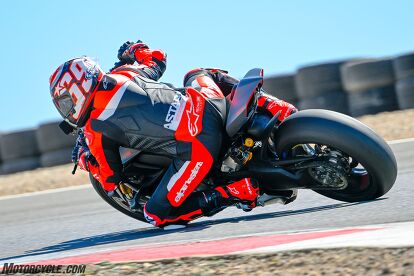
- Helmet: Arai Corsair-X Nicky Reset
- Suit: Alpinestars GP Plus v4 Race Suit
- Airbag: Alpinestars Tech-Air 5
- Gloves: Alpinestars GP Tech v2
- Boots: Alpinestars Supertech R
2023 Ducati Streetfighter V4 S Specifications | |
|---|---|
| Engine Type | Desmosedici Stradale 90° V4, rearward-rotating crankshaft, 4 Desmodromically actuated valves per cylinder, liquid-cooled |
| Displacement | 1,103 cc |
| Bore x Stroke | 81.0 mm x 53.5 mm |
| Compression Ratio | 14.0:1 |
| Power | 208 hp at 12,750 rpm (claimed) |
| Torque | 90.4 lb-ft. at 11,500 rpm (claimed) |
| Fuel Injection | Electronic fuel injection system. Twin injectors per cylinder. Full ride-by-wire elliptical throttle bodies. |
| Exhaust | 4-2-1-2 system, with 2 catalytic converters and 4 lambda probes. |
| Gearbox | 6 speed with Ducati Quick Shift (DQS) up/down EVO 2 |
| Primary drive | Straight cut gears; Ratio 1.80:1 |
| Ratio | 1=38/14 2=36/17 3=33/19 4=32/21 5=30/22 6=30/24 |
| Final drive | Chain 525; Front sprocket 15; Rear sprocket 42 |
| Clutch | Hydraulically controlled slipper dry clutch. Self-bleeding master cylinder |
| Frame | Aluminum alloy “Front Frame” |
| Front suspension | Öhlins NIX30 43 mm fully adjustable fork with TiN treatment. Electronic compression and rebound damping adjustment with Öhlins Smart EC 2.0 event-based mode |
| Front Wheel | 3-spoke forged aluminum alloy 3.50″ x 17″ |
| Front Tyre | Pirelli Diablo Rosso Corsa IV 120/70 ZR17 |
| Rear suspension | Fully adjustable Öhlins TTX36 unit. Electronic compression and rebound damping adjustment with Öhlins Smart EC 2.0 event-based mode. Aluminum single-sided swingarm |
| Rear Wheel | 3-spoke forged aluminum alloy 6.00″ x 17″ |
| Rear Tyre | Pirelli Diablo Rosso Corsa IV 200/60 ZR17 |
| Wheel Travel (Front/Rear) | 120 mm (4.7 inches) – 130 mm (5.1 inches) |
| Front Brake | 2 x 330 mm semi-floating discs, radially mounted Brembo Monobloc Stylema 4-piston calipers with Bosch Cornering ABS EVO. Self-bleeding master cylinder |
| Rear Brake | 245 mm disc, 2-piston caliper with Bosch Cornering ABS EVO |
| Instrumentation | Last generation digital unit with 5″ TFT color display |
| Dry Weight | 392 pounds (claimed) |
| Kerb Weight | 434 pounds (claimed) |
| Seat Height | 845 mm (33.3 inches) |
| Wheelbase | 1.488 mm (58.6 inches) |
| Rake | 24,5° |
| Trail | 100 mm (4 inches) |
| Fuel Tank Capacity | 17 l – 4.49 gallon (US) |
| Number of Seats | Dual seats |
| Safety Equipment | Riding Modes, Power Modes, Bosch Cornering ABS EVO, Ducati Traction Control (DTC) EVO 2, Ducati Wheelie Control (DWC) EVO, Ducati Slide Control (DSC), Engine Brake Control (EBC) EVO, Auto tire calibration |
| Standard Equipment | Ducati Power Launch (DPL), Ducati Quick Shift (DQS) up/down EVO 2, Full LED lighting with Daytime Running Light (DRL), Ducati Electronic Suspension (DES) EVO with Öhlins suspension and steering damper, Quick adjustment buttons, Auto-off indicators, Marchesini aluminum forged wheels, Lithium-ion battery, Passenger seat cover |
| Provided Equipment | Passenger seat and footpegs |
| Ready for | Ducati Data Analyser+ (DDA+) with GPS module, Ducati Multimedia System (DMS), Anti-theft, Heated grips |
| Warranty | 24 months unlimited mileage |
| Maintenance Service Intervals | 12,000 km (7,500 miles) / 12 months |
| Valve Clearance Check (Desmoservice) | 24,000 km (15,000 miles) |
We are committed to finding, researching, and recommending the best products. We earn commissions from purchases you make using the retail links in our product reviews. Learn more about how this works.
Become a Motorcycle.com insider. Get the latest motorcycle news first by subscribing to our newsletter here.

Troy's been riding motorcycles and writing about them since 2006, getting his start at Rider Magazine. From there, he moved to Sport Rider Magazine before finally landing at Motorcycle.com in 2011. A lifelong gearhead who didn't fully immerse himself in motorcycles until his teenage years, Troy's interests have always been in technology, performance, and going fast. Naturally, racing was the perfect avenue to combine all three. Troy has been racing nearly as long as he's been riding and has competed at the AMA national level. He's also won multiple club races throughout the country, culminating in a Utah Sport Bike Association championship in 2011. He has been invited as a guest instructor for the Yamaha Champions Riding School, and when he's not out riding, he's either wrenching on bikes or watching MotoGP.
More by Troy Siahaan



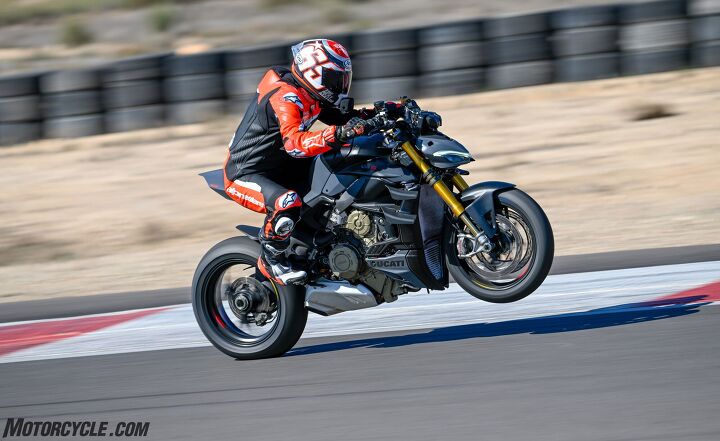









































































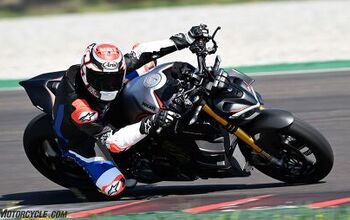
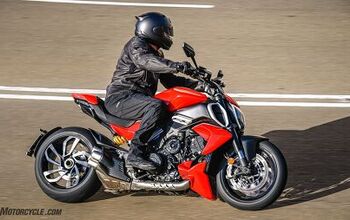
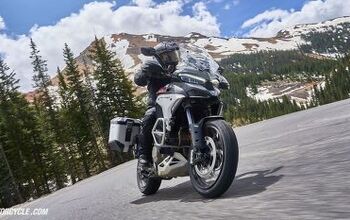














Comments
Join the conversation